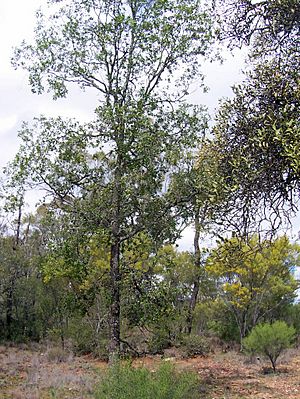Ooline facts for kids
Quick facts for kids Ooline |
|
|---|---|
 |
|
| Ooline (Cadellia pentastylis) at Gamilaroi Nature Reserve | |
| Conservation status | |
| Scientific classification | |
| Genus: |
Cadellia
|
| Species: |
pentastylis
|
The ooline (scientific name: Cadellia pentastylis) is a special type of tree found in Australia. It's the only species in its group, called Cadellia. This tree can grow quite large and has bright green leaves. Its bark looks rough, almost like a pattern of tiles.
The ooline tree comes from rainforests that existed long ago, during the Pleistocene Era. Back then, much of Australia was wetter than it is now. Ooline trees like to grow in good soil, often in areas that are also good for farming. Sadly, because many forests have been cleared, the ooline is now considered a vulnerable plant in Australia. This means it needs protection to survive.
Contents
What Does the Ooline Tree Look Like?
The ooline tree usually grows to about 10 meters (about 33 feet) tall. Sometimes, it can even reach 25 meters (about 82 feet)! Its leaves are arranged in a special way, one after another, and they are oval-shaped.
Flowers and Fruit
Ooline trees usually flower from October to December. Their flowers are small and white, with five petals that are about 5–7 millimeters long.
The fruit of the ooline tree is brownish and looks a bit wrinkled. It stays surrounded by five red leaf-like parts called sepals at its base. You can usually see the fruit from November to December. We don't know if humans can eat the ooline's fruit.
Where Do Ooline Trees Grow?
The Cadellia pentastylis is listed as vulnerable under an Australian law called the Environment and Biodiversity Conservation Act 1999. This law helps protect plants and animals that are at risk.
You can find small groups of ooline trees scattered in different places. They grow on the lower western slopes of Australia's Great Dividing Range. This area is between about 24ºS and 30ºS latitude.
Ooline Locations
- In NSW, you can find ooline trees around places like Tenterfield, Terry Hie Hie, Gunnedah, and Moree.
- You can also see ooline trees in Sundown National Park and Tregole National Park in Queensland.
How Scientists Study Ooline Trees
Scientists use different ways to study the ooline tree and understand its family connections. For example, they look closely at its pollen under powerful microscopes. This helps them see tiny details about its shape and surface.
By studying pollen and genes, scientists have found that the ooline tree is related to other plant families like Polygalaceae and Fabaceae. They also found strong links between Cadellia and a Mexican plant group called Recchia. These studies help us understand how different plants are connected around the world.
Images for kids






